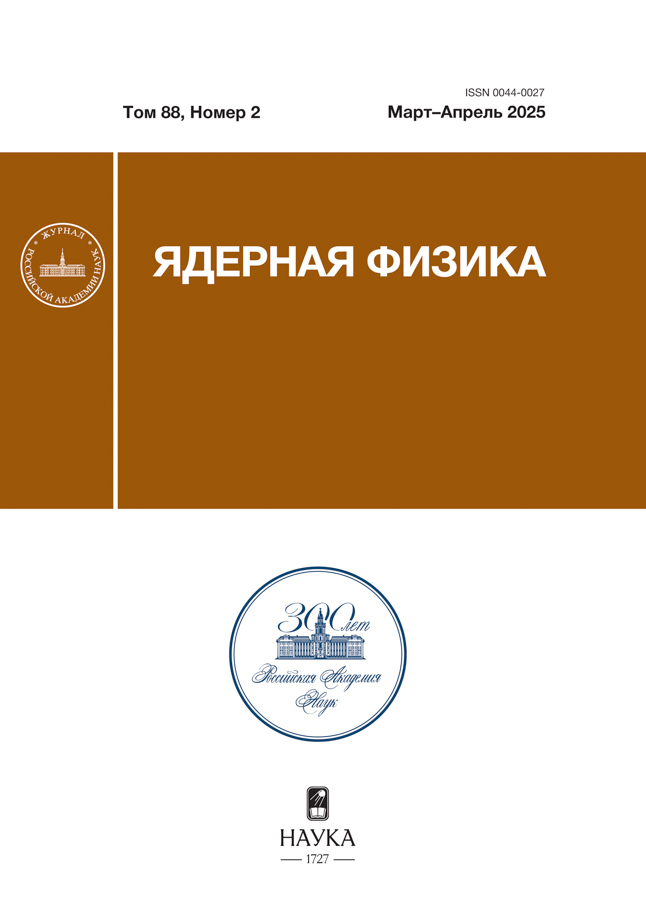Происхождение сигналов, зарегистрированных 23 февраля 1987 г. в гравитационных антеннах
- Авторы: Агафонова Н.Ю.1, Мальгин А.С.1
-
Учреждения:
- Институт ядерных исследований РАН
- Выпуск: Том 87, № 2 (2024)
- Страницы: 113-119
- Раздел: МАТЕРИАЛЫ LXXII МЕЖДУНАРОДНОЙ КОНФЕРЕНЦИИ “ЯДРО-2022: ФУНДАМЕНТАЛЬНЫЕ ВОПРОСЫ И ПРИЛОЖЕНИЯ”. Элементарные частицы и поля. Эксперимент
- Статья опубликована: 07.10.2024
- URL: https://transsyst.ru/0044-0027/article/view/674665
- DOI: https://doi.org/10.31857/S0044002724020088
- EDN: https://elibrary.ru/KRICXB
- ID: 674665
Цитировать
Полный текст
Аннотация
Во время вспышки SN1987A 23 февраля 1987 г. четыре подземных нейтринных детектора и две гравитационные антенны в Риме и Мэриленде зарегистрировали сигналы, связанные с гравитационным коллапсом ядра звезды. Поскольку зафиксировать антеннами прямое гравитационное излучение от коллапса SN1987A невозможно, до сих пор непонятно, какие события регистрировали гравитационные антенны. В настоящей работе проведен амплитудный анализ сигналов гравитационных антенн в Риме и Мэриленде в окрестности сигналов нейтринных детекторов во время Сверхновой SN1987A. Показано, что амплитудные распределения во всех сигналах антенн согласуются с распределением флуктуирующих энергопотерь атмосферных мюонов, пересекающих антенны. Сделано заключение о мюонном происхождении сигналов, детектируемых антеннами ‟веберовского” типа — алюминированными цилиндрами массой 2–3 т.
Полный текст
Об авторах
Н. Ю. Агафонова
Институт ядерных исследований РАН
Автор, ответственный за переписку.
Email: Agafonova@inr.ru
Россия, Москва
А. С. Мальгин
Институт ядерных исследований РАН
Email: Agafonova@inr.ru
Россия, Москва
Список литературы
- В. Л. Дадыкин, Г. Т. Зацепин, В. Б. Корчагин, П. В. Корчагин, А. С. Мальгин, О. Г. Ряжская, В. Г. Рясный, В. П. Талочкин, Ф. Ф. Хальчуков, В. Ф. Якушев, М. Альетта, Дж. Бадино, Дж. Болонья, К. Кастаньоли, Ф. Кастеллина, В. Фульджионе и др., Письма в ЖЭТФ 45, 464 (1987) [V. L. Dadykin, G. T. Zatzepin, V. B. Korchagin, P. V. Korchagin, A. S. Mal’gin, O. G. Ryazhskaya, V. G. Ryasnyi, V. P. Talochkin, F. F. Khal’chukov, V. F. Yakushev, M. Aglietta, G. Badino, G. Bologna, C. Castagnoli, A. Castellina, W. Fulgione, et al., JETP Lett. 45, 593 (1987)].
- M. Aglietta, G. Badino, G. Bologna, C. Castagnoli, A. Castellina, V. L. Dadykin, W. Fulgione, P. Galeotti, F. F. Kalchukov, B. Kortchaguin, P. V. Kortchaguin, A. S. Malguin, V. G. Ryassny, O. G. Ryazhskaya, O. Saavedra, V. P. Talochkin, et al., Europhys. Lett. 3, 1315 (1987).
- Е. Н. Алексеев, Л. Н. Алексеева, В. И. Волченко, И. В. Кривошейна, Письма в ЖЭТФ 45, 461 (1987) [E. N. Alekseev, L. N. Alekseeva, V. I. Volchenko, and I. V. Krivosheina, JETP Lett. 45, 589 (1987)].
- K. Hirata, T. Kajita, M. Koshiba, M. Nakahata, Y. Oyama, N. Sato, A. Suzuki, M. Takita, Y. Totsuka, T. Kifune, T. Suda, K. Takahashi, T. Tanimori, K. Miyano, M. Yamada, E. W. Beier, et al., Phys. Rev. Lett. 58, 1490 (1987).
- R. M. Bionta, G. Blewitt, C. B. Bratton, D. Casper, A. Ciocio, R. Claus, B. Cortez, M. Crouch, S. T. Dye, S. Errede, G. W. Foster, W. Gajewski, K. S. Ganezer, M. Goldhaber, T. J. Haines, T. W. Jones, et al., Phys. Rev. Lett. 58, 1494 (1987).
- T. Bronzini, S. Frasca, G. Pizzella, G. V. Pallottino, and G. Vannaroni, Nuovo Cimento C 8, 300 (1985).
- J. Weber, Phys. Rev. Lett. 22, 1320 (1969).
- E. Amaldi, P. Bonifazi, M. G. Castellano, E. Coccia, C. Cosmelli, S. Frasca, M. Gabellieri, I. Modena, G. V. Pallottino, G. Pizzella, P. Rapagnani, F. Ricci, and G. Vannaroni, Europhys. Lett. 3, 1325 (1987).
- M. Aglietta, A. Castellina, W. Fulgione, G. Trinchero, S. Vernetto, C. Castagnoli, P. Galeotti, O. Saavedra, E. Amaldi, S. Frasca, G. V. Pallottino, G. Pizzella, P. Rapagnani, F. Ricci, P. Astone, C. Cosmelli, et al., Nuovo Cimento C 14, 171 (1991).
- P. Galeotti and G. Pizzella, Eur. Phys. J. C 76, 426 (2016); arXiv: 1603.05076 [physics.gen-ph].
- P. Bonifazi, V. Ferrari, S. Frasca, G. V. Pallottino, and G. Pizzella, Nuovo Cimento C 1, 465 (1978).
- M. Aglietta, G. Badino, G. Bologna, C. Castagnoli, A. Castellina, W. Fulgione, P. Galeotti, O. Saavedra, G. Trinchero, S. Vernetto, E. Amaldi, C. Cosmelli, S. Frasca, G. V. Pallottino, G. Pizzella, P. Rapagnani, et al., Nuovo Cimento C 12, 75 (1989).
- D. H. Ezrow, N. S. Wall, J. Weber, and G. B. Yodh, Phys. Rev. Lett. 24, 945 (1970).
- В. С. Мурзин, Введение в физику космических лучей (Москва, Атомиздат, 1979).
- E. Amaldi and G. Pizzella, Nuovo Cimento C 9, 612 (1986).
- D. Javorsek II, P. A. Sturrock, R. N. Lasenby, A. N. Lasenby, J. B. Buncher, E. Fischbach, J. T. Gruenwald, A. W. Hoft, T. J. Horan, J. H. Jenkins, J. L. Kerford, R. H. Lee, A. Longman, J. J. Mattes, B. L. Morreale, D. B. Morris, et al., Astropart. Phys. 34, 173 (2010); arXiv: 1007.0924 [nucl-ex].
- J. H. Jenkins and E. Fischbach, Astropart. Phys. 31, 407 (2009).
- J. H. Jenkins, D. W. Mundy, and E. Fischbach, Nucl. Instrum. Methods A 620, 332 (2010).
- A. Parkhomov, J. Mod. Phys. 2, 1310 (2011).
- T. Mohsinally, S. Fancher, M. Czerny, E. Fischbach, J. T. Gruenwald, J. Heim, J. H. Jenkins, J. Nistor, and D. O’Keefe, Astropart. Phys. 75, 29 (2016).
- D. E. Alburger, G. Harbottle, and E. F. Norton, Earth Planet. Sci. Lett. 78, 168 (1986).
- E. D. Falkenberg, Apeiron 8, 32 (2001).
- E. Fischbach, V. E. Barnes, N. Cinko, J. Heim, H. B. Kaplan, D. E. Krause, J. R. Leeman, S. A. Mathews, M. J. Mueterthies, D. Neff, and M. Pattermann, Astropart. Phys. 103, 1 (2018); arXiv: 1801.03585.
- B. P. Abbott et al. (LIGO Scientific Collab. and Virgo Collab.), Phys. Rev. Lett. 119, 161101 (2017).
- B. P. Abbott, R. Abbott, T. D. Abbott, F. Acernese, K. Ackley, C. Adams, T. Adams, P. Addesso, R. X. Adhikari, V. B. Adya, C. Affeldt, M. Afrough, B. Agarwal, M. Agathos, K. Agatsuma, N. Aggarwal, et al., Astrophys. J. Lett. 848, L12 (2017).
- N. Agafonova, A. Malgin, and E. Fischbach; arXiv: 2107.00265 [nucl-ex].
Дополнительные файлы















